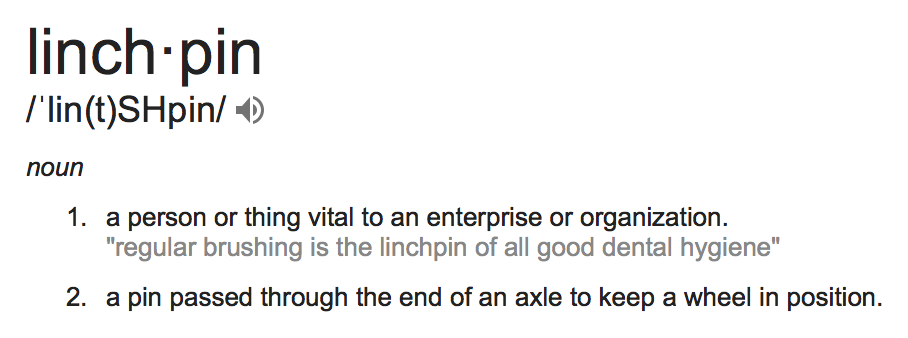In everyone’s life and leadership there are pivotal ‘aha!’ moments that simplify, clarify, and define our next steps going forward. Basically, they become teachable moments! I want to share one of mine. It happened to me 20 years ago as a young Area Director. Every Friday, we would gather for our three hour staff meeting. The time was rich but not unique in YL circles: food, fellowship, community, devotion, some to-do’s, and a teaching.
When I arrived Friday morning, I didn’t make it past the front door of the office before my staff barraged me with different needs they had for the YL Clubs they supervised. The list was long: ...a male to work with the freshman boys...a team leader on a WL team...a whole group of volunteers for a new Club... Parents to support the Capernaum ministry ...a musician...etc. They were desperate, passionate, anxious and somehow I had become the ‘clearing house’ for all volunteerism in my YL Area. I was immediately overwhelmed.
So we got to work, once the screaming and yelling had subsided, we made the decision to set aside the agenda for the day and sit down and talk about what had become the most pressing issue in the Area: ‘WE NEEDED MORE VOLUNTEERS!’ This is typical because ‘more volunteers’ is always at the top of every YL area’s list of needs. However, the next 45 minutes changed my perspective and approach on volunteerism forever.
Here is what happened:
First, I got out a pad and pen and asked everyone to list for me the ‘right now’ needs they had in their individual Clubs. We wanted a baseline of what we had to have to keep the area running. We went around the circle and the result was that we needed 15 VOLUNTEERS immediately! Men, women, parents, WL to College and everything in between!
Then, I asked everyone to bring out their Matthew 9:38 List. (“Ask the Lord of the harvest, therefore, to send out workers into his harvest field.”- Mt 9:38) We had been keeping this list of potential ‘workers’ to join us in ministry for a while so that wasn’t new either. For some that list was in their journal or notepad, for others it was tucked away in the back of their mind somewhere but we all had a list.
Now here is where it got fun! We shared our list of people, but then we brainstormed more, then we prayed some more, then we talked some more, then we debated, discussed, prayed and dreamed some more. What we typically gave a few moments of attention, we allowed to take the next 45 minutes. Talking, praying, thinking, dreaming, scheming, and asking ‘who else?’ It was amazing! The list kept growing and we slowly gained God’s perspective. I think sometimes we give five minutes to a topic, need, or problem that maybe deserves 45 minutes. We gave this one 45.
At the end of the 45 minutes, our cumulative Matthew 9:38 list was 147 NAMES! Remember, our need was 15, and we had close to 10x that on our prayer board! At the end of the meeting we realized that if only 10% of the folks that we had listed responded to the invitation to join us- we would be good to go! So as the dust settled, we decided on a few things going forward-.
EVERYONE in the YL Area had a vested interest in recruiting the next volunteer. Not just staff or Committee but everyone in the community!
We were going to continue to EXPAND that list by talking to our existing Volunteers in the area who also had Mt. 9:38 lists. (that was another 75 people and 75 lists! )
We were going to continue praying, dreaming and inviting this group. This list was going to grow and be a significant part of EVERY TIME we were together.
Lastly, we decided that we would be PERSONALLY INVITE all those people on the list to join us in becoming volunteers in the Area. The invitation would be face to face, specific, and intentional.
Yes, we doubled the number of volunteers because of that day! Finally, we realized that if we did three things well in our YL Area we would always identify enough volunteers but we would retain them too because they would be un-recruitable. They were:
Live out God’s calling in our life within the mission of YL.
Seeing change (transformation) in our community and in our own lives.
Having fun while we are at it!
HERE IS AN OPPORTUNITY FOR YOU! If you think walking through these steps may be a fit for your area then we want to help. Over the coming months we are accepting applications for 12 YL areas around the Globe to go through the same process that I went through as a cohort in an attempt to significantly increase the number of volunteer leaders in your area. We will do it together, step by step, and celebrate what happens when you invite someone into an area of gifting and a community of transformation. If you are interested in being one of the 12 - email TANK (kenbtank@gmail.com) and tell him you are interested in the +1 PILOT and we will send you a brief application and get you going. You may be 45 minutes away from doubling your leadership base!



















